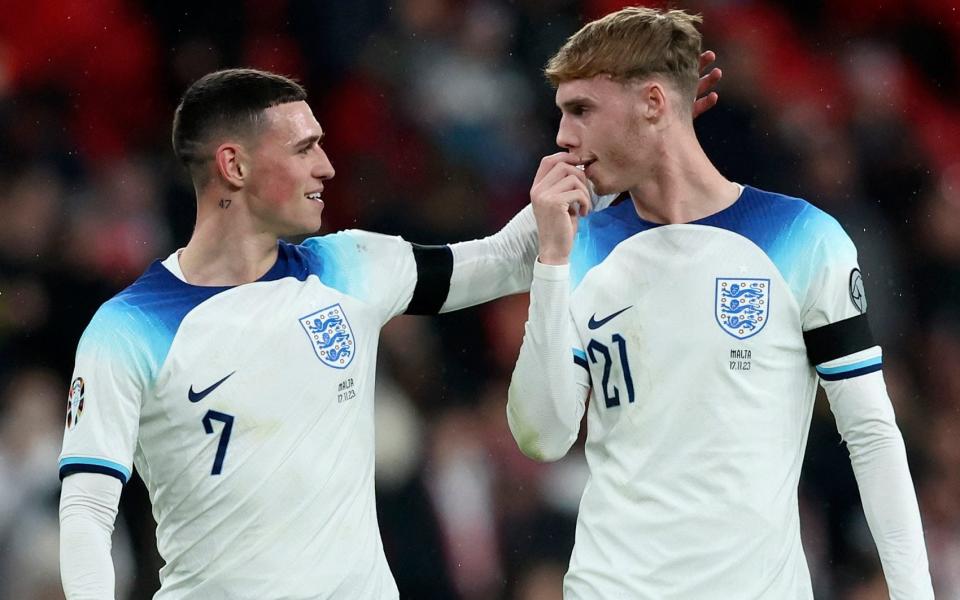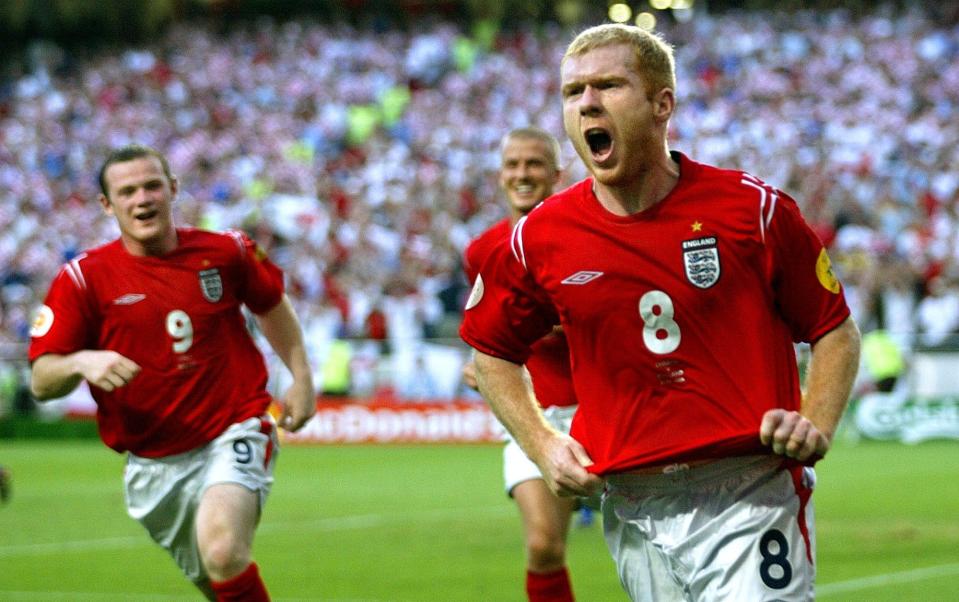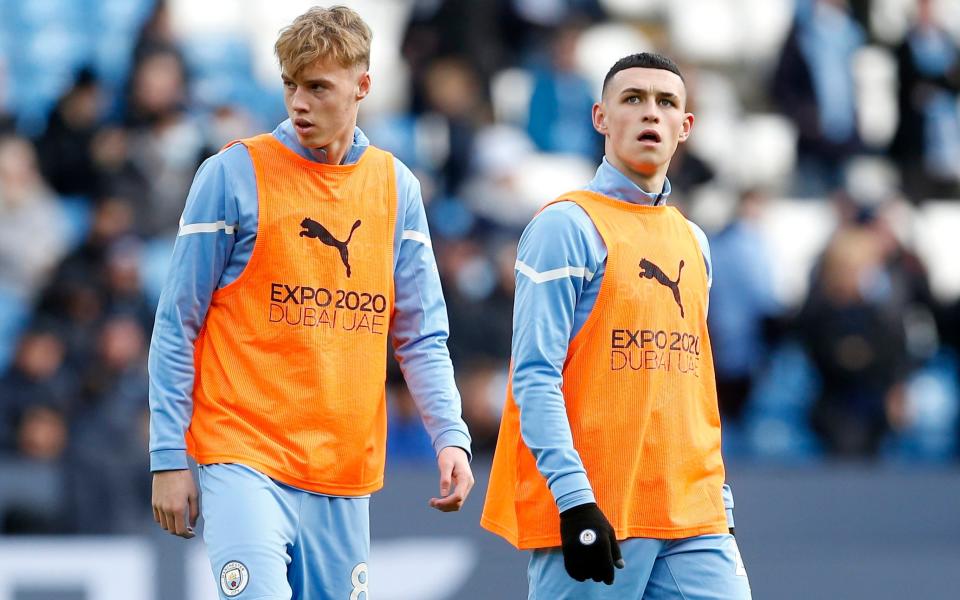England have a ‘Scholes dilemma’ with Cole Palmer – this is how you fix it

Will attempting to fit Jude Bellingham, Phil Foden and Cole Palmer into the England team be Gareth Southgate’s ‘Paul Scholes moment’?
It is not jumping on the bandwagon after their midweek hat-tricks to say that both Foden and Palmer should start for England at this summer’s European Championship. The cases over the course of the campaign are compelling and, in fact, there are five England players who have 30 or more goal involvements – goals and assists this season in Europe: Foden, Palmer, Bellingham, Harry Kane and Ollie Watkins.
Unfortunately for Watkins he is not going to displace Kane at centre-forward and, in truth, has so far failed to impress for England. His place in the squad is in jeopardy especially after Ivan Toney’s strong performance recently against Brazil.
The issue for Southgate is how does he make it work with the others? In that question there is an immediate comparison and the age-old debate for international managers: how do you get your best players into the team and still make it function?
For England there are therefore echoes of what Sven Goran-Eriksson faced when he tried to shoehorn Steven Gerrard, Frank Lampard and Scholes, alongside David Beckham, into the same side. His solution? Well, he struggled to find one as he took the easy option and sent Scholes out to unhappily play on the left with Gerrard and Lampard not really working effectively as a central midfield pairing. England looked far better once Owen Hargreaves was introduced.
“What do you do with Frank Lampard, Steven Gerrard and David Beckham?” Eriksson said. “The best solution if we wanted to use all four midfielders was to put, at that time, Scholes on the left.”
The problem was Scholes – despite Eriksson suggesting he was England’s best midfielder – certainly did not enjoy the positional shift. He ended his international career prematurely, after a disappointing Euros for him in 2004, aged 29. Later Scholes said he regretted it but playing out of position was a factor in his decision.
For Foden and Palmer the situation is very different. And not least because they are 23 and 21 respectively. Foden may have 33 caps but Palmer has just two – playing only 35 minutes in two Euro qualifiers against North Macedonia and Malta. But for a lack of fitness he would have featured in the last two games, the friendlies against Brazil and Belgium. Instead he watched as Anthony Gordon seized his chance.

Clearly Bukayo Saka deserves to start for England and will do so on the right of whatever formation Southgate settles on. At present, and with two warm-up games against Bosnia & Herzegovina and Iceland to play before heading to Germany, that is looking like a 4-2-3-1 approach.
Southgate appears to favour Bellingham in the number 10 role, where he has been featuring for Real Madrid, behind Kane. With Saka on the right it looks like Foden will compete with others for a place on the left – even though he has done his best work for Manchester City and England, of late, playing more centrally.
Palmer? He plays on the right, cutting in, for Chelsea. But he is unlikely to dislodge Saka. Plus there is also Jarrod Bowen. Southgate has Gordon, Marcus Rashford and Jack Grealish to consider for the left, also, and it is evident that not all will go to the Euros.
So what does he do? Palmer is left-footed even if his best work is from the inside right channel where he can pass infield on his stronger left side. He can play wide on either flank or as a number 10 and while he is not the quickest he has the skill to beat an opponent. Southgate could easily deploy him on the left – but surely not at Foden’s expense?
A solution is to move Bellingham back to partner Declan Rice in a double pivot. That would work but, really, do England want to limit Bellingham in that way even if they could give him the licence to go forward more often than Rice?
So what should Southgate do? There is an answer and it is to copy City’s approach. England could play 4-1-4-1. It would mean a four of Saka, Bellingham, Foden and Palmer (with the latter two interchanging) behind Kane and Rice as the sole holding midfielder in the Rodri role.

The key then would be to ask John Stones to step into midfield as he does for City but there is, unfortunately, a potential flaw (or two) in all of this. It really needs Luke Shaw to be fit and play on the left, and he is a serious doubt, with Kyle Walker on the right. But, above all, it requires Harry Maguire to be able to play as the dominant centre-half in the middle of that three. The fear would be he would be left exposed without Stones always there and does not have the mobility to cope.
What this does do, though, is get more of England’s attacking and creative players in the team. It will have crossed Southgate’s mind. He is brave enough to change and give young players their chance – most recently Kobbie Mainoo.
As ever for international managers fitting the pieces of the puzzle together is their greatest challenge and defines them. England have an exceptional squad, albeit one with clear deficiencies, and it is fair to argue that teams with the better defensive bases win tournaments. But sometimes it is also about going for it and using your best weapons in the best way. It would be a shame, and maybe a regret, if England’s outstanding young players are not utilised together. Southgate needs to have the best team on the pitch at the Euros and not the most exciting bench.

 Yahoo Sport
Yahoo Sport 





































